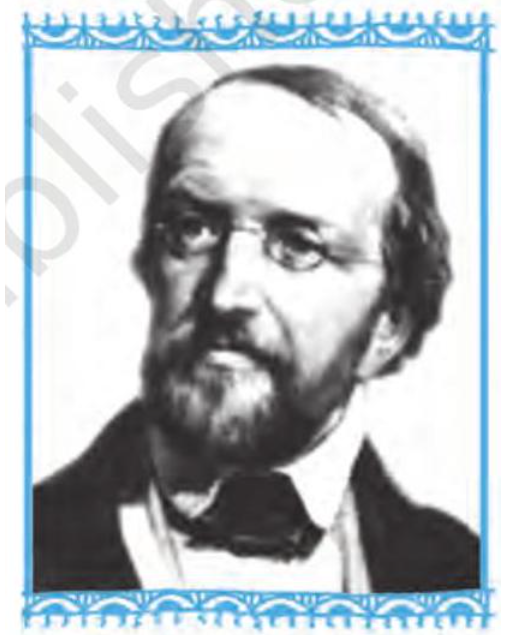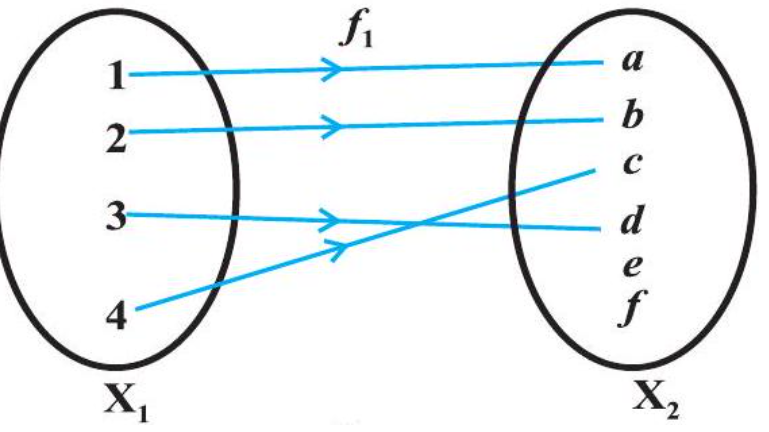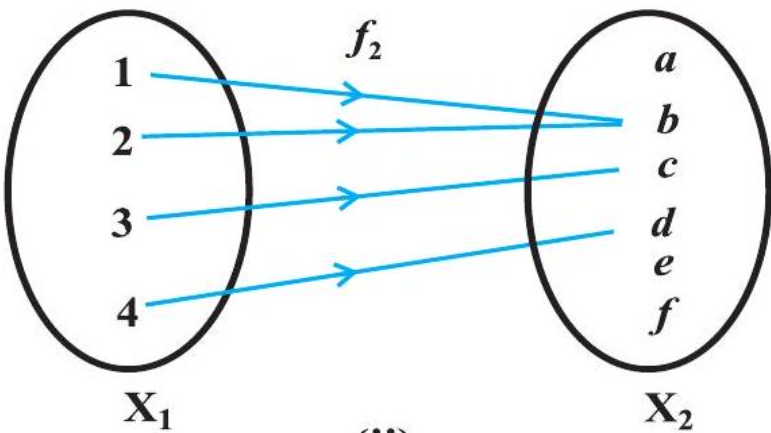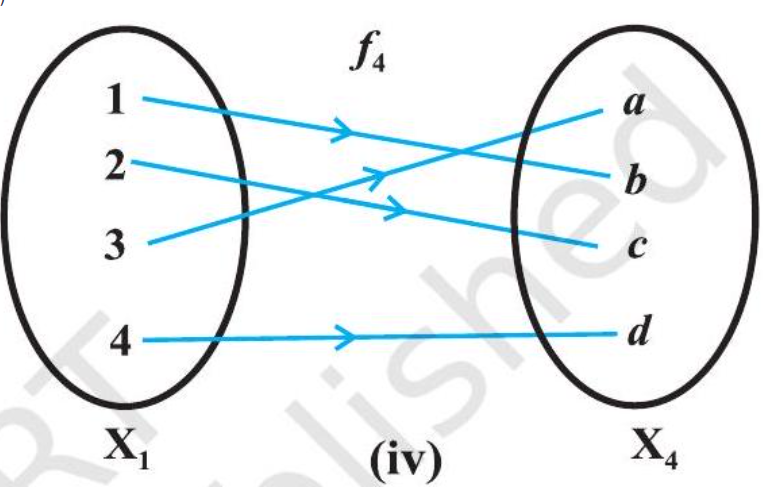Chapter 1 Relations And Functions
RELATIONS AND FUNCTIONS
There is no permanent place in the world for ugly mathematics … . It may be very hard to define mathematical beauty but that is just as true of beauty of any kind, we may not know quite what we mean by a beautiful poem, but that does not prevent us from recognising one when we read it. - G. H. HARDY
1.1 Introduction
Recall that the notion of relations and functions, domain, co-domain and range have been introduced in Class XI along with different types of specific real valued functions and their graphs. The concept of the term ‘relation’ in mathematics has been drawn from the meaning of relation in English language, according to which two objects or quantities are related if there is a recognisable connection or link between the two objects or quantities. Let A be the set of students of Class XII of a school and B be the set of students of Class XI of the same school. Then some of the examples of relations from $A$ to $B$ are
(i) $\{(a, b) \in A \times B: \text{a is brother of b}\}$
(ii) $\{(a, b) \in A \times B: \text{a is sister of b}\}$,

Lejeune Dirichlet (1805-1859)
(iii) $\{(a, b) \in A \times B : \text{age of a is greater than age of b}\}$,
(iv) ${(a, b) \in A \times B :}$
${\text{total marks obtained by a in the final examination is less than the total marks obtained by b in the final examination}}$,
(v) $\{(a, b) \in A \times B: a$ lives in the same locality as $b\}$. However, abstracting from this, we define mathematically a relation $R$ from $A$ to $B$ as an arbitrary subset of $A \times B$.
If $(a, b) \in R$, we say that $a$ is related to $b$ under the relation $R$ and we write as $a R b$. In general, $(a, b) \in R$, we do not bother whether there is a recognisable connection or link between $a$ and $b$. As seen in Class XI, functions are special kind of relations.
In this chapter, we will study different types of relations and functions, composition of functions, invertible functions and binary operations.
1.2 Types of Relations
In this section, we would like to study different types of relations. We know that a relation in a set $A$ is a subset of $A \times A$. Thus, the empty set $\phi$ and $A \times A$ are two extreme relations. For illustration, consider a relation $R$ in the set $A=\{1,2,3,4\}$ given by $R=\{(a, b): a-b=10\}$. This is the empty set, as no pair $(a, b)$ satisfies the condition $a-b=10$. Similarly, $R^{\prime}=\{(a, b):|a-b| \geq 0\}$ is the whole set $A \times A$, as all pairs $(a, b)$ in A $\times$ A satisfy $|a-b| \geq 0$. These two extreme examples lead us to the following definitions.
Definition 1 A relation $R$ in a set $A$ is called empty relation, if no element of $A$ is related to any element of $A$, i.e., $R=\phi \subset A \times A$.
Definition 2 A relation $R$ in a set $A$ is called universal relation, if each element of $A$ is related to every element of $A$, i.e., $R=A \times A$.
Both the empty relation and the universal relation are some times called trivial relations.
Remark In Class XI, we have seen two ways of representing a relation, namely raster method and set builder method. However, a relation $R$ in the set $\{1,2,3,4\}$ defined by $R$ $=\{(a, b): b=a+1\}$ is also expressed as $a R b$ if and only if $b=a+1$ by many authors. We may also use this notation, as and when convenient.
If $(a, b) \in R$, we say that $a$ is related to $b$ and we denote it as $a R b$.
One of the most important relation, which plays a significant role in Mathematics, is an equivalence relation. To study equivalence relation, we first consider three types of relations, namely reflexive, symmetric and transitive.
Definition 3 A relation $R$ in a set $A$ is called
(i) reflexive, if $(a, a) \in R$, for every $a \in A$,
(ii) symmetric, if $(a_{1}, a_{2}) \in R$ implies that $(a_{2}, a_{1}) \in R$, for all $a_{1}, a_{2} \in A$.
(iii) transitive, if $(a_{1}, a_{2}) \in R$ and $(a_{2}, a_{3}) \in R$ implies that $(a_{1}, a_{3}) \in R$, for all $a_{1}, a_{2}$, $a_{3} \in A$.
Definition 4 A relation $R$ in a set $A$ is said to be an equivalence relation if $R$ is reflexive, symmetric and transitive.
1.3 Types of Functions
The notion of a function along with some special functions like identity function, constant function, polynomial function, rational function, modulus function, signum function etc. along with their graphs have been given in Class XI.
Addition, subtraction, multiplication and division of two functions have also been studied. As the concept of function is of paramount importance in mathematics and among other disciplines as well, we would like to extend our study about function from where we finished earlier. In this section, we would like to study different types of functions.
Consider the functions $f_{1}, f_{2}, f_{3}$ and $f_{4}$ given by the following diagrams.
In Fig 1.2, we observe that the images of distinct elements of $X_{1}$ under the function $f_{1}$ are distinct, but the image of two distinct elements 1 and 2 of $X_{1}$ under $f_{2}$ is same, namely $b$. Further, there are some elements like $e$ and $f$ in $X_{2}$ which are not images of any element of $X_{1}$ under $f_{1}$, while all elements of $X_{3}$ are images of some elements of $X_{1}$ under $f_{3}$. The above observations lead to the following definitions:
Definition 5 $ A$ function $f: X \rightarrow Y$ is defined to be one-one (or injective), if the images of distinct elements of $X$ under $f$ are distinct, i.e., for every $x_{1}, x_{2} \in X, f(x_{1})=f(x_{2})$ implies $x_{1}=x_{2}$. Otherwise, $f$ is called many-one.
The function $f_{1}$ and $f_{4}$ in Fig 1.2 (i) and (iv) are one-one and the function $f_{2}$ and $f_{3}$ in Fig 1.2 (ii) and (iii) are many-one.
Definition 6 A function $f: X \rightarrow Y$ is said to be onto (or surjective), if every element of $Y$ is the image of some element of $X$ under $f$, i.e., for every $y \in Y$, there exists an element $x$ in $X$ such that $f(x)=y$.
The function $f_{3}$ and $f_{4}$ in Fig 1.2 (iii), (iv) are onto and the function $f_{1}$ in Fig 1.2 (i) is not onto as elements $e, f$ in $X_{2}$ are not the image of any element in $X_{1}$ under $f_{1}$.

(i)

(iii)

(ii)

(iv)
Fig 1.2 (i) to (iv)
Remark $f: X \rightarrow Y$ is onto if and only if Range of $f=Y$.
Definition 7 A function $f: X \rightarrow Y$ is said to be one-one and onto (or bijective), if $f$ is both one-one and onto.
The function $f_{4}$ in Fig 1.2 (iv) is one-one and onto.
1.4 Composition of Functions and Invertible Function
In this section, we will study composition of functions and the inverse of a bijective function. Consider the set A of all students, who appeared in Class X of a Board Examination in 2006. Each student appearing in the Board Examination is assigned a roll number by the Board which is written by the students in the answer script at the time of examination. In order to have confidentiality, the Board arranges to deface the roll numbers of students in the answer scripts and assigns a fake code number to each roll number. Let $\mathrm{B} \subset \mathbf{N}$ be the set of all roll numbers and $\mathrm{C} \subset \mathbf{N}$ be the set of all code numbers. This gives rise to two functions $f: \mathrm{A} \rightarrow \mathrm{B}$ and $g: \mathrm{B} \rightarrow \mathrm{C}$ given by $f(a)=$ the roll number assigned to the student $a$ and $g(b)=$ the code number assigned to the roll number $b$. In this process each student is assigned a roll number through the function $f$ and each roll number is assigned a code number through the function $g$. Thus, by the combination of these two functions, each student is eventually attached a code number.
This leads to the following definition:
Definition 8 Let $f: A \rightarrow B$ and $g: B \rightarrow C$ be two functions. Then the composition of $f$ and $g$, denoted by $g \circ f$, is defined as the function $g \circ f: A \rightarrow C$ given by
$$ g o f(x)=g(f(x)), \forall x \in A . $$

Fig 1.5
Definition 9 A function $f: X \rightarrow Y$ is defined to be invertible, if there exists a function $g: Y \rightarrow X$ such that $g \circ f=I_{X}$ and $f \circ g=I_{Y}$. The function $g$ is called the inverse of $f$ and is denoted by $f^{-1}$.
Thus, if $f$ is invertible, then $f$ must be one-one and onto and conversely, if $f$ is one-one and onto, then $f$ must be invertible. This fact significantly helps for proving a function $f$ to be invertible by showing that $f$ is one-one and onto, specially when the actual inverse of $f$ is not to be determined.
Summary
In this chapter, we studied different types of relations and equivalence relation, composition of functions, invertible functions and binary operations. The main features of this chapter are as follows:
Empty relation is the relation $R$ in $X$ given by $R=\phi \subset X \times X$.
-
Universal relation is the relation $R$ in $X$ given by $R=X \times X$.
-
Reflexive relation $R$ in $X$ is a relation with $(a, a) \in R \forall a \in X$.
-
Symmetric relation $R$ in $X$ is a relation satisfying $(a, b) \in R$ implies $(b, a) \in R$.
-
Transitive relation $R$ in $X$ is a relation satisfying $(a, b) \in R$ and $(b, c) \in R$ implies that $(a, c) \in R$.
-
Equivalence relation $R$ in $X$ is a relation which is reflexive, symmetric and transitive.
-
Equivalence class $[a]$ containing $a \in X$ for an equivalence relation $R$ in $X$ is the subset of $X$ containing all elements $b$ related to $a$.
-
A function $f: X \rightarrow Y$ is one-one (or injective) if $f(x_{1})=f(x_{2}) \Rightarrow x_{1}=x_{2} \forall x_{1}, x_{2} \in X$.
-
A function $f: X \rightarrow Y$ is onto (or surjective) if given any $y \in Y, \exists x \in X$ such that $f(x)=y$.
A function $f: X \rightarrow Y$ is one-one and onto (or bijective), if $f$ is both one-one and onto.
- Given a finite set $X$, a function $f: X \rightarrow X$ is one-one (respectively onto) if and only if $f$ is onto (respectively one-one). This is the characteristic property of a finite set. This is not true for infinite set
Historical Note
The concept of function has evolved over a long period of time starting from R. Descartes (1596-1650), who used the word ‘function’ in his manuscript “Geometrie” in 1637 to mean some positive integral power $x^{n}$ of a variable $x$ while studying geometrical curves like hyperbola, parabola and ellipse. James Gregory (1636-1675) in his work " Vera Circuli et Hyperbolae Quadratura" (1667) considered function as a quantity obtained from other quantities by successive use of algebraic operations or by any other operations. Later G. W. Leibnitz (1646-1716) in his manuscript “Methodus tangentium inversa, seu de functionibus” written in 1673 used the word ‘function’ to mean a quantity varying from point to point on a curve such as the coordinates of a point on the curve, the slope of the curve, the tangent and the normal to the curve at a point. However, in his manuscript “Historia” (1714), Leibnitz used the word ‘function’ to mean quantities that depend on a variable. He was the first to use the phrase ‘function of $x^{\prime}$. John Bernoulli (1667-1748) used the notation $\phi x$ for the first time in 1718 to indicate a function of $x$. But the general adoption of symbols like $f, F, \phi, \psi \ldots$ to represent functions was made by Leonhard Euler (1707-1783) in 1734 in the first part of his manuscript “Analysis Infinitorium”. Later on, Joeph Louis Lagrange (1736-1813) published his manuscripts “Theorie des functions analytiques” in 1793, where he discussed about analytic function and used the notion $f(x), F(x)$, $\phi(x)$ etc. for different function of $x$. Subsequently, Lejeunne Dirichlet (1805-1859) gave the definition of function which was being used till the set theoretic definition of function presently used, was given after set theory was developed by Georg Cantor (1845-1918). The set theoretic definition of function known to us presently is simply an abstraction of the definition given by Dirichlet in a rigorous manner.






